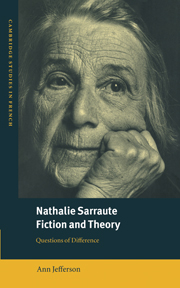Death and the impossible difference
Published online by Cambridge University Press: 22 September 2009
Summary
At the end of the last chapter we saw that when a difference is opened up in the heart of things it becomes possible for writing to capture the ‘scrap of living substance’ which is its goal. But even this internal difference is liable to differ from itself; for it is just as often associated with death in Sarraute's writing as it is with life. The breach that introduces internal difference is itself split between being a sign of life and a portent of death. In these concluding pages I shall be exploring the particularly volatile forms of difference that cluster around the issue of death in Sarraute's work, and hope in the process to demonstrate both how intractable that cluster is, and also how imbroiled it is with the writing project itself. In short, by the intensity of its focus on issues of sameness and difference, rupture and continuity, loss and identification, death proves to be the ultimate testing ground for Sarraute's writing.
Though it does not figure as a large-scale theme in her work death is nonetheless a topic which repeatedly surfaces in it, and moreover very often in association with the appearance of a breach in things. From Tropismes to Ici, the tiniest fissure can provide a conduit for the intolerable menace which death represents for Sarraute:
par la fente minuscule, une menace indéfinissable, quelque chose d'implacable, d'intolérable, qui est là, derrière, toujours prêt à s'insinuer, s'infiltre sournoisement… (PI, p. 145)
[through the tiny fissure, an undefinable threat, something implacable, intolerable, that exists on the other side, always ready to insinuate itself, keeps stealthily seeping through (p. 152)]
- Type
- Chapter
- Information
- Nathalie Sarraute, Fiction and TheoryQuestions of Difference, pp. 171 - 182Publisher: Cambridge University PressPrint publication year: 2000



